Untitled Document
Tree Root Barrier Options
Whether landscaping or paving/concreting an area of your grounds, known as hardscaping, it's a huge investment, takes a great deal of work and can be quite expensive. If, instead, you installed a one-time tree root barrier system, you will have years of security from roots, minimal work and is a very affordable remedy. If roots and weeds are allowed to grow, you can experience a great deal of damage to landscapes and hardscapes from uncontrollable growth. This in turn well end out costing even more time and money to correct. You should be spending your time on other projects instead of repairing damaged landscapes and hardscapes, digging out and cutting back roots.
A barrier will significantly decrease the potential of roots developing and penetrating buildings, walls and hardscape foundations. The utilization of these barriers for both residential and commercial areas are already protecting many communities from expensive repairs due to buckled sidewalks, cracked foundations and destroyed driveways.
What Causes Overgrown Roots:
When soil dries out, large trees and shrubs will have their roots spread out in search of moisture. Until roots find moisture, they will continue to search and expand and will eventually penetrate foundations and other areas that are made from cement. A properly installed barrier will direct the roots downward and away from structures.
The Cut-Off Wall:
Expensive renovations and repairs are in the future if overgrown and expanding roots continue on their path of destruction. If a barrier is put in place, even in a damaged area, it can stop the area from becoming even more damaged. For many years, a cut-of wall has been the chosen solution and has been somewhat effective.
A cut-off wall is used as a vertical barrier that is placed 3 feet from its footings. It can prevent any further root movement while stabilizing the soil and controlling any increase of clay. This particular wall is constructed from an 11-inch reinforced concrete trench that is 5 to 15 feet deep. The downside, cut-off walls are very expensive to build and can often fail, considering it is made out of concrete.
Different Types of Barriers:
The most inexpensive and effective barrier is a pre-manufactured product. It is the most inexpensive choice for preventing moisture stabilization and overgrowth of roots. This root control system consists of heavy duty polypropylene that is 40 to 60 mil in thickness. It is a very sturdy and impenetrable barrier to prevent the expansion of root growth. The barrier wall will also prevent excessive dampness and moisture from the surrounding soil. Another type of barrier is a fabric like material with a built-in herbicide. This form of barrier is discussed in further detail below.
There are four different varieties of barriers available that are used in different ways. Here are descriptions of the different types of barriers for your consideration:
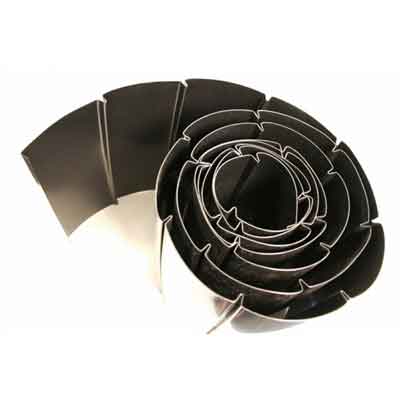
|
|
Tree Root Barrier Sheet
|
Sheet Material Barriers:
This system is manufactured from durable HDPE (High Density Polyethylene). It helps to hold moisture in the soil while preventing the movement of roots which cause damage to hardscapes and possibly other nearby structures. The sheet material barrier measures 20-foot long, which is perfect for linear planting applications. It can be cut to produce a certain measurement and can be applied to individual planted trees. When trying to control invasive weeds or grasses sheet barriers can be an effective option as when compared to panel type barriers there are typically few if any joints which is advantageous when trying to keep out tiny roots. For bamboo and invasive weed control
Bamboo Barrier, which is made from HDPE is ideal. If trying to contain grasses with very shallow roots, plastic or aluminum edging can be an effective solution.
EP Series Barriers:
This is an injection molded High Impact Polypropylene ((HIPP) modular barrier. The EP series allows for multiple panels to be joined together using a joining strip. It also has a T-top edge which will prevent overgrowth of roots. There are external flanges, at the base, so panels can be locked in the ground.
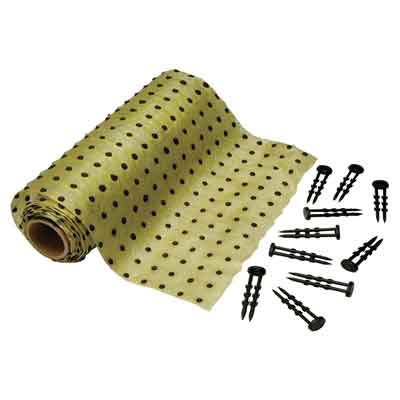
|
|
BioBarrier Root Control Fabric
|
BioBarrier Root Control:
Landscapes and hardscapes are an enormous investment and methods used in the past have been timely, a great deal of work and very expensive. Choosing a one-time installation of a BioBarrier Root Control System, or BioBarrier Weed Control System, will ensure years of security from roots and weeds growing where they are unwanted.
These easy to use systems will stop constant maintenance that are a thing of the past. This will allow you to spend more time and money on other projects. These nodules are on a durable geotextile drainage fabric which is the secret to their success. These systems contain trifluralin and this is how they work:
Roots grow when their root tip cells divide, trifluralin is an effective, non-systemic herbicide. It creates a zone around your landscape and hardscape areas, preventing root growth.
By using BioBarrier root control, when tree roots reach the barrier they are stopped. Roots outside the barrier zone will continue to naturally grow. When used as a weed control, the weeds' root system cannot grow due to the trifluralin area that is next to the fabric. The root systems of trees and shrubs are well below this zone and are therefore not affected by the herbicide.
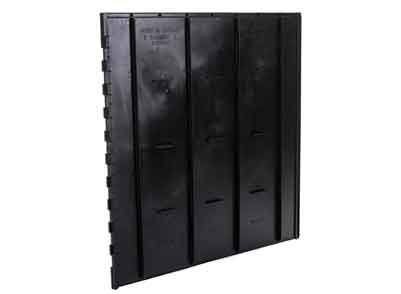
|
|
Deeproot Root Barrier Panel
|
DeepRoot Panels:
These barriers are patented mechanical guides that will redirect tree roots away from your hardscapes, eliminating expensive root damage while maintaining the health and beauty of mature trees. Deeproot panels are used for continuous surrounding and root pruning applications for both new and existing trees.
Continuous Application or Linear Application:
This application provides maximum hardscape protection while using all available rooting space in order to improve tree health. It places barriers in a straight line, directly along your hardscape for total protection.
Surrounded Application:
This application protects hardscapes that are surrounding all four sides of plantings. This allows for maximum available uncompacted soil volume, offering immediate root growth.
Root Pruning Application:
This application will prevent injury while preserving trees that are causing hardscape damage. Destructive roots are cleanly cut and removed and a Linear Barrier is installed.
In Conclusion:
Landscaping and hardscaping takes a great deal of work, can be time consuming and expensive. In order to protect your project you need to implement newer barrier solutions. Not only will they save you from having to start over, due to damage brought on by tree or weed roots, but also protect your trees.
With the proper installation of a barrier, you will have your landscaping and hardscaping in excellent condition for many years to come. You will not experience buckling and destruction of statue bases, driveways and walkways. At the same time, your wonderful mature or new trees will continue to grow and thrive.
We offer a full line of tried and proven excellent barriers for your particular needs. Contact us for assistance in choosing what will work best for your and your projects.
DeepRoot Barrier Panels – Material Composition
DeepRoot uses two specific plastics in almost all its products, polypropylene (PP) and polyethylene (PE), You might wonder why one product is used in a specific product but not in another. To answer that, you need to understand where the plastic comes from before asking why they are used in certain applications but not in others.
For many years, all plastic resins have been made using petrochemical raw materials including natural gas or crude oil. Lately, some resins have been made using organic raw materials such as natural starches or sugars like corn and sugarcane. That said, the volume is significantly low and the price is very high.
To date, using petrochemical materials with natural gas is the least expensive way to create large volumes of resin. Natural gas is made of a mixture of propane, ethane, and methane gases to create different resins. Polypropylene (PP) comes from propane, polyethylene (PE) from ethane, and polystyrene from methane.
PP and PE are the highest in volume and lowest in cost materials with good usable physical properties. Because they are so abundant, they are available in reprocess conditions. Reprocessed, or recycled, the material can include post-industrial material which comes from plastic processing plants and materials that did not make it to market.
Manufacturing
DeepRoot manufacturers its root barriers in two ways using two kinds of plastic. For injection molding they use PP and for extrusion they use PE. For injection molding versus extrusion, injection molding is the procedure of injecting material into a mold. For every positive space, there will be a negative space in the mold. Extrusion is like writing or creating something on a wedding cake. Extrusion is the procedure used to create objects from a fixed, cross-sectional profile.
As an example, 36-inch and 48-inch root barriers are so very large, that injection molding is not effective or economical. For the extruded process, PE is the right plastic. Because the profile is filed and one-directional, the 36-inch and 48-inch root barriers do not have a double topped edge or ground locks like the 12-inch, 18-inch, and 24-inch.
For injection molding, the properties of the PP make it the right choice. PP is a bit stiffer than PE and molds without distortion, PE under the same conditions will look like a wrinkled-up mess, it will be warped due to uneven shrinking. Due to good molding, relatively low cost, availability, and acceptable properties, PP is the better choice because of its resistance to alkalis and acids that are found in soil. Therefore PP was the choice for their injection molded parts.
Another important thing to know, their 36-inch and 48-inch root barriers are made from 100% recycled PE, and their 12-inch, 18-inch, and 24-inch root barriers are made from 75% recycled PP.
For quite some time now, root barriers have been at the heart of DeepRoot's business. They take their business very seriously by designing the best products to achieve effective ways to eliminate pavement and sidewalk heaving caused by tree roots.
Everyone, at some time or another, has tripped over a walkway that has buckled due to root growth and this is where DeepRoot comes into play. Obviously, trees are not trying to ruin your day, their roots are just naturally growing in different directions and some of those directions are upward. The right blend of soil and water are responsible for the health and growth of trees.
The heavily compacted subsoil in urban areas is most welcoming to the growth of plants and trees and happens to be close to the surface where roots are often located.
Root barriers are chosen to line the perimeter of the planting hole or whatever side borders the hardscape, i.e. sidewalk or pathway. When the roots reach the planting hole and come in contact with the barrier, they will head downward. Also, vertical ribs along the surface of the barrier will prevent circling. When the roots reach the bottom of the barrier, they will continue to grow underneath the barrier away from the surface paving.
Can Root Barriers Harm Trees?
If correctly installed Root Barriers will not harm trees. Root barriers are actually very easy to install but like other things, something can go wrong. As an example, a barrier was installed almost 18-inches below grade. It's not surprising it didn't work. In many cases, people have incorrectly installed barriers in a manner that encircles the root ball rather than lining the perimeter of the planting hole. It's recommended you leave at least 3-inches or more between the edge of the root ball and the barrier.
If panels are not placed correctly, they will likely be less effective, but will not harm the tree. While the barriers are not difficult to install, like anything else it does have to be done properly for the very best results.
DeepRoot was founded in 1976 when a prominent area was inundated with major sidewalk upheavals and a well-known industrial designer tripped and fell, wreaking a new pair of shoes.
The Right Soil Volume for Urban Trees
Trees need a good level of oxygen-rich soil to survive and there are policies in place by arborists to improve better-growing conditions for trees in urban areas.
The office of James Urban, FASLA, works with designers to provide 1,000 cubic feet (28 cubic meters) of soil for each tree. It could be slightly less if the soil is being shared by 2 trees. There are some container studies that show different results but further research is required.
How large trees will grow will depend on a number of factors including the species, soil quality, site hydrology, and more. Experts know the ratio depends on the amount of available soil and the size of the tree. You can expect a tree receiving 1,000 cubic feet of soil to reach around 16-inches in diameter and a 32-foot canopy.
1,000 cubic feet of soil per tree could have a major impact on urban tree canopy cover. Although the recommended number is a lot to aim for, very few city policies will ever be that ambitious. Ontario is leading the way followed by Toronto, Markham, Kitchener, and Oakville. These places have mandated 30 cubic meters, just over 1,000 cubic feet, of soil per street tree.
These policies require extra planning and will approach infrastructure projects differently and will have a major impact on reducing sewer overflow, flooding, and non-point source pollution because 1,000 cubic feet of Bioretention soil can conservatively hold 200 cubic feet of water. Bioretention is the process of removing contaminants and sediments from stormwater runoff.
There are implications for on-site stormwater management and low-impact development. When possible, people need to think of the two factors as one and integrate trees and soil into larger city policies. Also, the realistic size of trees and soil can keep water from entering the sewer system. There could be a lot more money for stormwater projects in areas where trees and soil are undervalued. Consider the role of trees and plants in bioretention by improving dissolved phosphorous retention, dissolved nitrogen retention, and factors that affect vegetation performance and the benefits of stormwater quality. Also, the rate control benefits of bioretention with trees in non-compacted soil.
There are many factors that will affect how much rooting space is available for trees in a given area. That said, if you want recommendations on what soil volume to aim for when designing urban trees, you should start with 1,000 cubic feet of soil and see how close you will get.
The Depth Of An Oak Tree's Roots?
Most oak tree roots will grow in the top 18-inches of soil (45 cm). These roots spread laterally (sideways or outward) from the tree which is approximately 3 to 7 times wider than the spread of the tree's branches. The deepest root of an oak tree is the taproot which grows straight down beneath the trunk of the tree to a depth of 3 to 5 feet (1-1.5 meters).
Oak Tree Summary -
· The lateral oak roots usually grow at a depth of 18-inches
· The lateral roots grow 3 to 7 times the circumference of the oak's branches.
· The oak's taproot grows to a depth of 3 to 5 feet
Instead of trying to imagine an oak tree's roots looking like the above-ground branches, see a network of shallow roots that spread far and wide to gather all the needed nutrients and keeps it firmly in place.
Do The Oak's Roots Grow Downward Or Outward?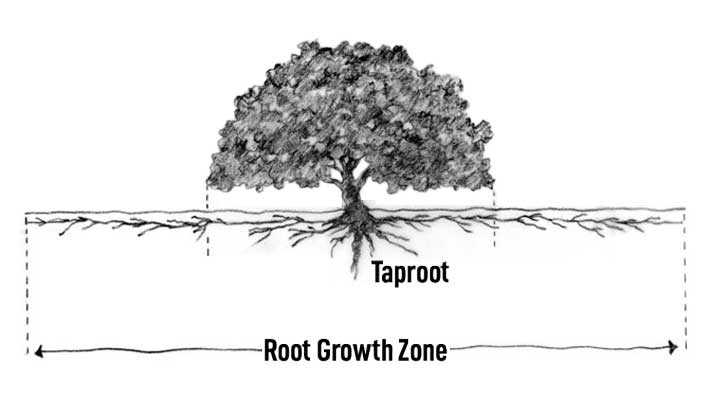
The roots of an oak tree grow outward from the tree, not downward. The majority of the roots that support the oak tree are within the top 18-inches of the soil. There is only one root that grows downward and that's the taproot. This root grows straight down into the soil and is normally 3 to 5 feet in depth.
Most oak tree roots grow outward not downward.
The taproot is the only root that grows straight down below the trunk.
The roots of a mature oak tree can spread outward by 75 to 250 feet (20-75 meters)
The roots that spread out the farthest from the tree are extremely thin with hairlike fibers.
As the oak's roots spread out over 250 feet, they will taper off drastically the further they move from the tree. Most of these roots will be as thin as fibers or hair-like vs the larger roots.
Are The Roots Of An Oak Tree Invasive?
If they are growing within 20 feet of a structure, these roots can cause a great deal of damage to the structure. Structures include pools, paved surfaces, foundations, and much more.
Keep In Mind -
Oak trees should be at least 20 feet (6 meters) from homes, paved surfaces, pools, underground water lines, sewer lines, septic tanks, and other structures. 30 feet (9 meters) is a much safer distance.
Oak roots can invade water lines, septic systems, and other structures if too close.
The roots of an oak tree can buckle pavement including sidewalks and driveways Again, there should be a distance of 20 feet or more.
Oak tree roots spread further than any other species of tree. Because the roots are shallow, oaks are among the most likely to destroy nearby surfaces and structures.
Will Oak Trees Damage Structures Including Foundations?
As mentioned, oak trees can damage structures and paved areas including water lines, walkways, and foundations connected to structures.
The roots of an oak tree can be a major threat to your home when you consider the following situations -
The roots from an oak tree can damage foundations that are within 20 feet (6 meters) of the tree's trunk.
If the distance is greater than 20 feet, the roots will be too small to cause any significant damage to a foundation.
You should consult with an arborist if you feel your oak tree is posing a threat to foundations including the foundation of your home.
Once the roots are over 20 feet from the trunk, the roots will be very fine like threads. Even though they may spread hundreds of feet, the roots will be too small to become a threat to your home or other foundations. If you feel there is a predominant threat, contact a tree removal service to have the tree removed.
Will Cutting Off Roots Harm The Tree?
Cutting oak tree roots should be limited to only critical areas where root intrusion is causing structural damage. Roots within a 20-foot radius of an oak tree trunk should be cut with care as these roots are critical for supporting the tree and keeping it in an upright position.
How Deep Do An Oak Tree's Roots Grow
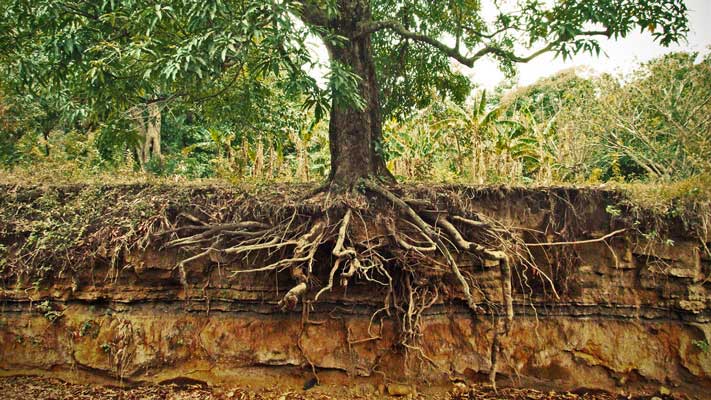
In general, oak tree roots are very shallow but will spread laterally. The majority of oak trees have a root system that does not exceed 18 inches below the surface. On the other hand, they can spread 3 to 7 times the circumference of the tree's branches in comparison to other trees that only have a lateral root spread of 2 to 3 times the size of their branch spread.
Now that you know the facts about oak trees, consider where these trees are located and whether you should consider having them cut down by a professional service or know everything is far out of the tree's reach. If all is good, take care of these magnificent trees and fall in love with the incredible shade they will provide you.
Do Pine Trees Have Deep Or Shallow Roots?
Pine trees are one of the most well-known trees but most people know very little about them. The tree has deep roots that conform with the tree's size. The taproot system starts with primary roots that continually dive deep into the soil looking for water. Due to its deep root system, the pine tree is one of the sturdiest trees around.
Due to the tree's taproot system, the roots will range from 3 feet to over 75 feet depending on the size of the tree, the root structure, climate, and spacing with other trees.
Like other trees, the height of the tree will dictate the size of the roots. A small pine around 4 to 10 feet will have shallower roots than a pine coming in at 50 to 100 feet in height. Pine trees normally take between 25 and 30 years to reach full maturity with a 50-plus root depth.
Similar to other taproot trees, pine trees start developing primary roots which follow a vertical direction into the ground looking for water. When the tree is a seedling, the roots are fine and soft but as the tree grows, the roods become coarse and will sprout secondary lateral roots that will move in various directions depending on the water source and soil conditions. The primary roots will continue to grow downward as long as the tree is alive.
Moisture And Soil Conditions
The biggest influence on root depth will depend on moisture and soil conditions. The higher the soil moisture and oxygen content, the deeper the tree's roots will grow. Sometimes, pine trees have to deal with adjusting to different soil types. Clay soils are good at retaining moisture, but their closely packed particles do not leave a lot of room for oxygen. Sandy soils have air space but will lose moisture very quickly.
Research has shown that pine trees develop best in loamy or sandy soils with an average particle size of 0.002 to 0.02 mm. Sandy or loamy soils will dry up faster which causes the root system to travel even deeper in search of water.
Cutting Root Systems
If you feel a tree's roots are becoming an issue, and you cut the roots it can lead to other problems. Cutting roots closer than 8 to 10 feet from the base of the tree can cause the tree to fall or due to a lack of water and nutrients, it will rot.
If you need to cut back on roots, make sure to stay over 10 feet from the trunk of the tree. If you feel the roots are causing structural issues you would be better off having the entire tree removed.
Are Foundations At Risk From Pine Tree Roots?
Pine trees, in general, are not as big a threat to house foundations as other varieties of trees because their roots run vertically. That said, the horizontal pine tree roots should be taken a little more seriously. Trees with shallow roots, like oaks and elms, are a bigger threat to the foundation and structural damage. Over a period of time, the roots will place pressure on walls and foundations leading to cracking. Please note, that shallow-rooted trees require a great deal more water than their deep-rooted counterparts. Due to their enormous need for water, the trees will drain the surrounding soil very quickly. Drainage can lead to shifts in the soil which can be bad for nearby foundations. On the other hand, pine trees' roots grow vertically which is good for homeowners and their foundations. Pine trees put very little pressure on foundations if any at all. Unlike hardwoods, pine trees do not have a huge thirst for water so the soil around your home will not drain out.
If you are worried about your foundation, there are several steps you can take to minimize a pine tree's impact on the foundation. You can prune the leaves on the tree. The more leaves, the higher the need for water will be. Pruning will help prevent soil drainage which can lead to issues with your foundation.
Another alternative, plant the trees further away from buildings and foundations to play it safe. You could look into modern technology such as subterranean imaging to see the depth of the tree's roots.
How Far Should Your Pine Trees Be From Your Home?
Be sure to plant the pine trees as far away from your home as possible. Aesthetics should never play an important role when it comes to the condition of your foundation. Keep in mind, because pine trees' roots run vertically, if placed too close to the structure, there could be issues as they grow. These trees should be planted at least half the anticipated height. If the tree can reach 100 feet tall, it should be at least 50 feet away from your home and foundation. You are running a big risk if you plant these trees too close to your home. Due to their unique root systems, there are no exceptions to the rule.
The Best Tree Removal Choices
If you have a pine tree that is too close to your home, you might not have a choice but to have the tree removed. Above and beyond all else, you should contact a professional tree removal service. In general, pine trees are pretty easy to take down which is why this is a popular procedure in the timber industry.
Removing The Roots
Once the tree is down, according to many professionals, you should work on cutting the roots from the stump. Be sure to clear the area around the tree's base and dig up the topsoil until the main roots are visible. You have to use a chainsaw or ax to cut the roots off. You do not have to worry about minor roots, they will die off in time.
Stump Removal
Once the main roots are cut, you have to decide whether to keep or remove the stump. Be warned, stumps may attract insects including termites which is not good news. Also, if the tree was diseased, the stump will still harbor the infection which can affect other plants in your garden area. You can use a stump grinder to remove the stump or use chemicals or allow it to rot over time. The grinder is the best and fastest way to take care of the situation.
Finally, you will have to treat the remaining soil to make it good for future plant life. You can use lime to help control pH levels and boost soil fertility.
Root Barriers are the Ideal Root Intrusion Defense
Pine trees are not exactly on the top of the list of trees that can cause damage to your home's foundation. Trees, of all kinds, and their root systems can be a concern and should be dealt with before it turns into a serious issue. Bringing down trees that might be potential hazards is one solution but if you want alternatives to keep the tree, there might be potential issues surfacing later on.
Right: DeepRoot Barrier panels installed along a road and sidewalk
Pine trees are not exactly on the top of the list of trees that can cause damage to your home's foundation. Trees, of all kinds, and their root systems can be a concern and should be dealt with before it turns into a serious issue. Bringing down trees that might be potential hazards is one solution but if you want alternatives to keep the tree, there might be potential issues surfacing later on.
If the tree is dead but left alone, its slender trunk could cause the tree to fall onto structures and cause even greater damage.
Pine tree root systems are very long and very deep in the soil. Other varieties of trees can spread out more vs having a deep taproot system. Learn all you can about the trees on your property that are nearby structures before making a final decision.
|